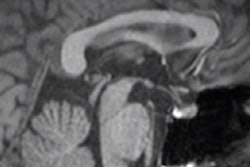The molecular subtype of malignant brain tumors plays an important role in determining survival prospects. Patients who have tumors with isocitrate dehydrogenase (IDH) 1 mutations or 1p and 19q gene codeletion will have better outcomes than those who have tumors without the mutations, according to presenter Dr. Cheng-Yu Chen of Taipei Medical University.
Over the past couple of years, the research team has been evaluating the use of radiomics: an image analysis method in which imaging features are converted to thousands of textures in an approach similar to geographic analysis, he said.
"The mindset is that, since the imaging appearance of a brain tumor (the phenotype) is tweaked by the genomic alternation, we can actually look back from imaging to guess the genotypes -- thus getting another set of information for survival," Chen said.
The team trained and tested a machine-learning algorithm using imaging and genomic data from the U.S. National Cancer Institute's Cancer Imaging Archive (TCIA). The model showed promising performance in predicting IDH1 mutations and 1p and 19 q codeletion in cases from the archive, according to Chen.
"In other words, we can do prediction of patient's survival without getting genomic data from brain tissue, thanks to the TCIA training and validation," he said.
Delve deeper into this research by attending the presentation on Wednesday.



















